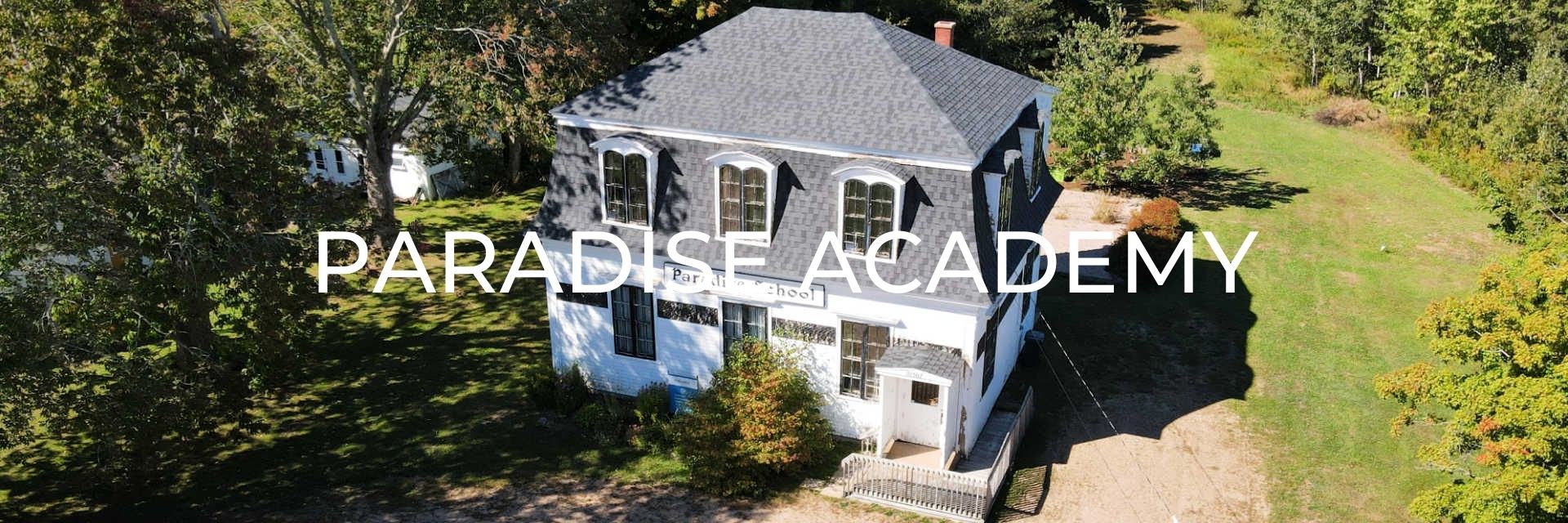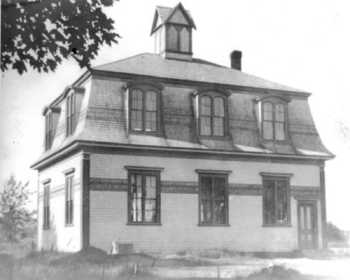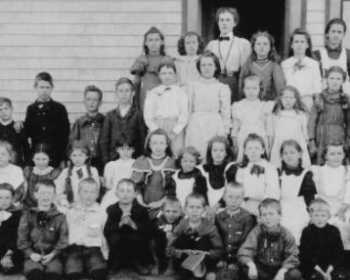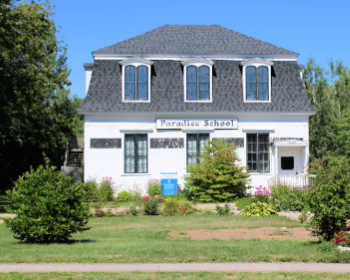
THE paradise ACADEMY
Written by Barbara Bishop
Our school is a standing symbol of the remarkable story of education in the village of Paradise. Paradis Terrestre was resettled by New England Planters after the deportation of the Acadians. The huge majority of these Planters came from Massachusetts, and one of the oddities of the commonwealth of Mass was that they were religious dissenters. That is, they demanded the right to interpret scriptures for themselves, instead of having church authorities do that. That meant they had to know how to read the scriptures. For over a century educating children to read was valued in New England, and that value was imported to the Annapolis Valley in the 18th century, along with the desire for representative government, a township model of governance, and town hall meetings.
 The first generation who came struggled just to get through winters, crop failures, summer drought, insect and rodent invasions, and the need to clear land and build on it. But within two generations, there were records of eight schools in Wilmot Township, on Hwy 1 between Bridgetown and Kingston. Paradise consisted of 12 land grants of 500 acres each, extending from the sign at “Bridgetown East” today to the first grant past Lilly’s. We were the major settlement in Wilmot, and we had two of the eight schools. By “school” we mean space provided, maybe in a house, and a teacher hired. These were “near Martins” which I think means the house next to the hall on the east, and near Leonard’s’, both on Hwy 1. But the first actual schoolhouse was on Phinney’s property. It was known as the “Pepper Box” because of all the peppery times. The teacher had a drinking problem, would often pass out, and the story goes that the kids would lay him out so he could sleep comfortably and they would kind of rampage around. But the Vidito, Balcom, and Starratt children among others, managed to learn anyway. These and later schools were provided entirely by subscriptions from community citizens. Universal education came later and was greatly resisted- the New England mindset of dissenting- don’t tell us what you think we should do- lived on it seems.
The first generation who came struggled just to get through winters, crop failures, summer drought, insect and rodent invasions, and the need to clear land and build on it. But within two generations, there were records of eight schools in Wilmot Township, on Hwy 1 between Bridgetown and Kingston. Paradise consisted of 12 land grants of 500 acres each, extending from the sign at “Bridgetown East” today to the first grant past Lilly’s. We were the major settlement in Wilmot, and we had two of the eight schools. By “school” we mean space provided, maybe in a house, and a teacher hired. These were “near Martins” which I think means the house next to the hall on the east, and near Leonard’s’, both on Hwy 1. But the first actual schoolhouse was on Phinney’s property. It was known as the “Pepper Box” because of all the peppery times. The teacher had a drinking problem, would often pass out, and the story goes that the kids would lay him out so he could sleep comfortably and they would kind of rampage around. But the Vidito, Balcom, and Starratt children among others, managed to learn anyway. These and later schools were provided entirely by subscriptions from community citizens. Universal education came later and was greatly resisted- the New England mindset of dissenting- don’t tell us what you think we should do- lived on it seems.
Eventually, a teacher named Asaph Marshall, who lived in Clark Walton’s’ house, donated land (which didn’t get officially recorded in his lifetime) on this site, and a school was built which stood in front of this building. Uncle Asaph was beloved, so his high standards influenced many. He taught Shakespeare, Milton, Dafoe, Goldsmith, Bunyan. He started a library in his home. I have an old copy of Milton’s Paradise Lost which I think may have come from that library. He also made fishing nets out of horsehair, and brooms out of split ash as he taught so I assume the students learned those practical skills as well. He taught from 1831-38.
In 1850 we find Paradise recognized by the province’s education Superintendant as academically excellent- no other rural areas had a higher standard than Paradise, under teacher Jarvis Hart, who taught British literature, philosophy, astronomy, French, German, Latin and Greek. Caleb Phinney, who lived in David and Gregory’s house and taught in the 1860s, had a passion for mathematics. John Johnson, I hope still has the preserved copy of this man’s homemade math teaching book that he and Julie found in the house
 It was in 1894 that this building was completed and dedicated. It took lots of debate and wrangling over repair old bldg. or build a new one, but when it was decided, it was decided to build something truly fine. Anne Marie’s grandfather, Ernest Balcom, won the tender to build it. The school had two departments, as the old one did. A young woman in the community always taught the primary department, and the advanced students were taught by a man. The male teacher, university educated, acted as principal. After the provincial Normal School was established, the young female teachers from the community had more professional training, and though they could not teach once they married, they raised the level of discourse and learning in their communities and encouraged the children to stay in school. They were also a vital part of the thriving Literary Societies formed in Maritime rural communities. Ours met in a building recently torn down on George Milligan’s property, then the Harold and Lillian Leonard Longley home. We had Shakespeare, Thackeray, Dickens, Eliot, Jane Austen-loving farmers and wives here. I have a library of some of the books owned by my grandparents who were active members.
It was in 1894 that this building was completed and dedicated. It took lots of debate and wrangling over repair old bldg. or build a new one, but when it was decided, it was decided to build something truly fine. Anne Marie’s grandfather, Ernest Balcom, won the tender to build it. The school had two departments, as the old one did. A young woman in the community always taught the primary department, and the advanced students were taught by a man. The male teacher, university educated, acted as principal. After the provincial Normal School was established, the young female teachers from the community had more professional training, and though they could not teach once they married, they raised the level of discourse and learning in their communities and encouraged the children to stay in school. They were also a vital part of the thriving Literary Societies formed in Maritime rural communities. Ours met in a building recently torn down on George Milligan’s property, then the Harold and Lillian Leonard Longley home. We had Shakespeare, Thackeray, Dickens, Eliot, Jane Austen-loving farmers and wives here. I have a library of some of the books owned by my grandparents who were active members.
We have a list of over 80 Paradise Academy graduates who went on to make huge contributions to Nova Scotia and other places. University professors, doctors of medicine, political leaders of stature- e.g. Avard Longley, the first Member of Parliament for Annapolis County after Confederation and the Railway Commissioner who brought the railroads to Nova Scotia, and his cousin J Wilberforce Longley, an Attorney General of NS who fought for human rights ahead of his time, many university-trained and ordained clergy, musicians, artists, teachers, lawyers, a Minister of Education, historian, wealthy philanthropist, Member of British Empire awarded this for his horticultural and marketing work with the apple industry, Engineers, a statistician for the Dept of Agriculture, Acadian and Harvard MA, who began the first Tourism Department of Nova Scotia.
A few events of interest- Just before this school was built, in 1892, the principal decided to have an arbour day on May 8, which went on for years. He said it was for “decorating the school grounds, cultivating the esthetic faculty of the pupils and popularizing and spreading some elementary principles of forestry”. Using the decomposed chips from the school woodpile, they planted and mulched 51 trees on this property. I wonder if any are still here- they planted 20 rock or sugar maples, 6 elms, 2 yellow birches, 3 Hackmatack, 4 Ash, 2 locusts,1 oak, 1 white birch. A number would have been removed two years later when they built the school! In 1927 on Arbor Day 25 rock maples were planted on these grounds.
 This school was a wonder in Annapolis County. Can you imagine the “Patriotic Demonstration” of July 1, 1900., with 2-3000 people attending. Right here. There were union jacks everywhere, strung across the street, as the write-up said, ‘shouting with their gay colour and beautiful ensign, “Loyalty! Loyalty! ” There was a parade with mounted riders, militia, school children, militia, private carriages- 400 units in all. A speaker’s platform in front of the school draped with bunting, a new flag donated by the prominent Pearson family- from Jim and Joan Biers’ home- and when two school girls unfurled it the crowd hurrahed again and again for Queen and country and the Pearsons. No wonder it was possible for so many young men to march enthusiastically off to the slaughter and folly of World War I.
This school was a wonder in Annapolis County. Can you imagine the “Patriotic Demonstration” of July 1, 1900., with 2-3000 people attending. Right here. There were union jacks everywhere, strung across the street, as the write-up said, ‘shouting with their gay colour and beautiful ensign, “Loyalty! Loyalty! ” There was a parade with mounted riders, militia, school children, militia, private carriages- 400 units in all. A speaker’s platform in front of the school draped with bunting, a new flag donated by the prominent Pearson family- from Jim and Joan Biers’ home- and when two school girls unfurled it the crowd hurrahed again and again for Queen and country and the Pearsons. No wonder it was possible for so many young men to march enthusiastically off to the slaughter and folly of World War I.
Attendance rose and fell depending on the state of history. E.g. declined during the Depression. After the post-war baby boom bulge, attendance declined, a fever of regionalization heated up, and our school was finally closed in 1979, over a furious and heartbroken protest in Paradise. As the Women’s Institute, which had provided so much support for this school and its children for over 60 years pleaded, when you take away our school, you take away the heart of our community. And they were right. So maybe it’s up to us to restore the heart of our community. With the Hall and the School, the buildings and gardens and parks and programs we can plan, let’s create a renewed and vibrant “downtown Paradise” for gathering and enjoying and learning as those people once called “Paradisonians”, as our benefactor WI Morse called us, tongue in cheek, long ago.
